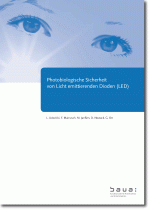Photobiological safety of light emitting diodes (LEDs)
(in German)
Fifty years after their invention, light emitting diodes (LEDs) are conquering more and more applications and are increasingly being used in both professional and private spheres. From an occupational health and safety perspective, since the rapid progress of LED-technology leads to ever more powerful LEDs, the question of their photobiological safety arises. Which directives and standards are to be observed in carrying out the risk assessment?
In assessing the safety of employees at workplaces with LEDs, the European Directive 2006/25/EC on artificial optical radiation has to be considered. This Directive sets out the minimum requirements and exposure limit values in order to protect the eyes and skin of employees against risks arising from artificial optical radiation and is implemented into German national law by the Ordinance on artificial optical radiation (OStrV). The required measurement methods and the calculation methodology are set in the harmonized standard DIN EN 62471:2009 "Photobiological safety of lamps and lamp systems". The standard divides the sources of incoherent optical radiation (such as incandescent and fluorescent lamps, LEDs, etc.) into four groups: in the Exempt Group (no photobiological risk) and the Risk Groups 1 to 3 with increasing hazard potential.
This report presents the results of the photobiological safety evaluation of different LEDs following the requirements of the Lamp Safety Standard. Predominantly, LEDs in the visible spectrum were studied. As an example only two LEDs that emit in the ultraviolet and in the infrared spectral region were assessed. Due to exceeding the emission limit value for photochemical retinal damage the examined LEDs in the visible spectrum (34 single LEDs with or without lens, three LED torches, five LED lamps, one LED reflector) have reached the Risk Group 2 at most. None of the emission limit values for thermal retinal hazard has been exceeded. Hence, the photochemical retinal hazard is the dominant threat by LEDs in the visible spectrum.
Almost all LEDs which exceeded the emission limit value of the Exempt Group were white or blue LEDs (except for one green LED). During a deliberate long-term close-distance look into a white or blue LED, the exposure limit value for photochemical retinal hazard can be exceeded in only 10 seconds. The sum of single exposures at certain workplaces (such as the LED industry, the installation of lighting systems or the theater and stage lighting) can exceed this time rapidly.
Please download the complete report "Photobiological safety of light emitting diodes (LEDs)" (in German only).
Bibliographic information
Title: Photobiologische Sicherheit von Licht emittierenden Dioden (LED).
1. edition.
Dortmund:
Bundesanstalt für Arbeitsschutz und Arbeitsmedizin, 2013.
ISBN: 978-3-88261-726-9, pages: 195, Project number: F 2115, PDF file
